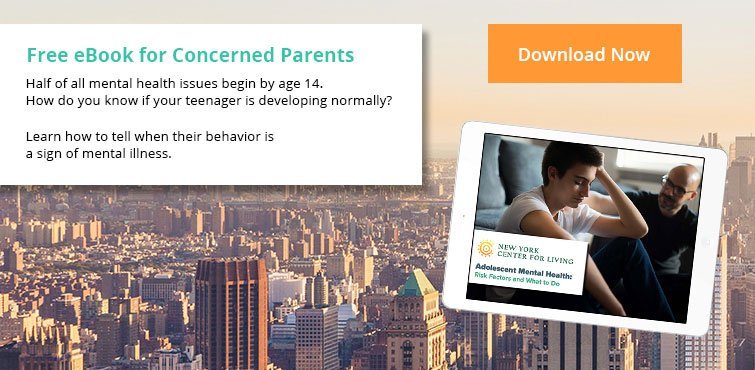
This article is part of a series. For the fully designed ebook, click here.
Risk Factors and Protective Factors for Adolescent Mental Illness
Some adolescents have a higher risk than others for developing a mental illness, including a substance use disorder. According to the Substance Abuse and Mental Health Services Administration, risk factors include genetic, biological, environmental and cultural considerations1.
Genetics
A family history of mental illness may increase your child’s risk for developing one, too, although most people with a mental illness don’t have relatives with the same mental illness.
Stress
Chronic stress can lead to anxiety and depression and is a major risk factor for substance abuse.
Trauma
Traumas such as physical, emotional or sexual abuse; neglect; witnessing or being the victim of violence; or surviving a natural disaster can lead to post-traumatic stress disorder, characterized by nightmares, insomnia, anxiety, anger, flashbacks and a startle response. PTSD is an important risk factor for substance abuse as a form of self-medication.
Identity Issues
Adolescents who are questioning their gender identity or sexual orientation may be at a higher risk for anxiety and depression, especially if they don’t have their family’s support or support in the community.

Family Dysfunction
A dysfunctional or chaotic home life can lead to symptoms of mental illness. This is especially true if the dysfunction stems from a parent’s substance abuse problems, according to an article in the journal Social Work in Public Health2. Children who live with a parent struggling with an addiction may have difficulties forming healthy peer relationships, experience problems at school and develop a mental illness. They’re also at an increased risk for developing a substance use disorder.
Other Illnesses
Young people with developmental disabilities and chronic medical conditions may develop anxiety or depression. They are also at an elevated risk for developing a substance use problem.
Poverty
Adolescents from poor families may experience considerable stress, and the insecurity and uncertainty that comes with poverty can lead to mental illness and self-medicating with drugs or alcohol.
Involvement in the Juvenile Justice System
Adolescents in the justice system – particularly girls – have a considerably higher risk for developing symptoms of mental illness and substance use disorders than those who aren’t in the system.
Substance Abuse
Drug and alcohol abuse leads to changes in brain function that can cause mental illnesses like anxiety and depression.
Some of these risk factors can be reduced by certain protective factors, the most important of which is a supportive family and community.
Protective Factors for Mental Illness
Protective factors are those that help reduce the risk of mental illness. One of the most important protective factors for mental illness and substance abuse is family stability and support. When the family is stable, children are less likely to develop anxiety and depression, and when they feel supported, they’re more likely to have higher self-esteem and make better choices. LGBTQ adolescents who have love and support at home are far less likely than those with an un-accepting family to develop a mental illness or engage in substance abuse.
Other protective factors include a strong community, a supportive social network and healthy, nurturing relationships.
Despite these protective factors, some adolescents will still develop a mental illness or substance use disorder, for various reasons. The protective factors then become a source of support that helps young people cope with and recover from a mental health disorder.
The Signs and Symptoms of Adolescent Mental Illness and How It’s Treated
Each type of mental illness has its own signs and symptoms. However, not everyone will experience every symptom of a mental illness, and symptoms vary from person to person. Adolescents may have symptoms just once, or they may occur infrequently. This can make it difficult to know whether the problem is a mental illness or just the challenging emotions that occur in adolescence.
According to the National Institute of Mental Health, your child may need help if he or she3:
- Frequently feels anxious, stressed or worried
- Has frequent tantrums or is extremely irritable much of the time
- Has frequent headaches or stomachaches that have no physical explanation
- Can’t sit still for any length of time
- Has trouble sleeping or has frequent nightmares
- Loses interest in activities they once enjoyed
- Withdraws from friends or family
- Does poorly in school or experiences a decline in grades
- Is obsessed with a fear of gaining weight and exercises or diets excessively
- Has low energy or no energy
- Periodically has spells of intense activity
- Engages in self-harm behaviors like cutting
- Engages in risky, self-destructive behaviors
- Abuses drugs or alcohol
- Has suicidal thoughts
- Hears voices, feels out of control or believes their mind is controlled
If any of these signs or symptoms last for weeks or months, and they interfere with your child’s daily life at home and school, talk to a health professional. Early treatment will not only improve your child’s quality of life, but it can help prevent more severe and lasting problems later.
How Treatment Works
High quality treatment for a mental illness or substance use disorder takes a holistic approach to treatment that addresses issues of body, mind and spirit. Holistic treatment builds on your child’s strengths and involves a variety of therapies and interventions, which are based on your child’s unique needs and issues.
According to the Substance Abuse and Mental Health Services Administration, medication isn’t typically the primary form of treatment for most adolescents. Rather, treatment is a combination of therapies that help young people:
- Address relevant issues
- Resolve underlying problems
- Identify and change dysfunctional thinking and behaving patterns
- Develop the skills and strategies they need to cope with self-destructive thoughts, negative emotions, and other triggers
- Increase self-awareness, self-confidence and self-esteem
- Develop healthy habits
- Make healthy choices
When medication is used to treat a mental illness, it’s almost always used alongside therapy, which leads to better mental health.
Therapies Commonly Used in Treatment
Depending on the diagnosis and your child’s needs, a variety of therapies will likely be used to address mental health issues. Some of the most common therapies used in mental health treatment include:
Cognitive-behavioral therapy, (CBT) which helps individuals identify and change dysfunctional thought and behavior patterns.
Dialectical behavior therapy, (DBT) which helps teens reduce conflicts in their personal relationships and develop critical emotional coping skills.
Acceptance and commitment therapy, (ACT) which helps adolescents develop psychological flexibility. This teaches them to think and act in ways that honor their personal values.
Family therapy, which helps restore optimal function to the family system through improved communication and resolving a variety of issues.
Exposure therapy, which helps young people with intense phobias overcome their fears.
Complementary therapies, such as yoga and meditation, which can help increase self-awareness and mindfulness.